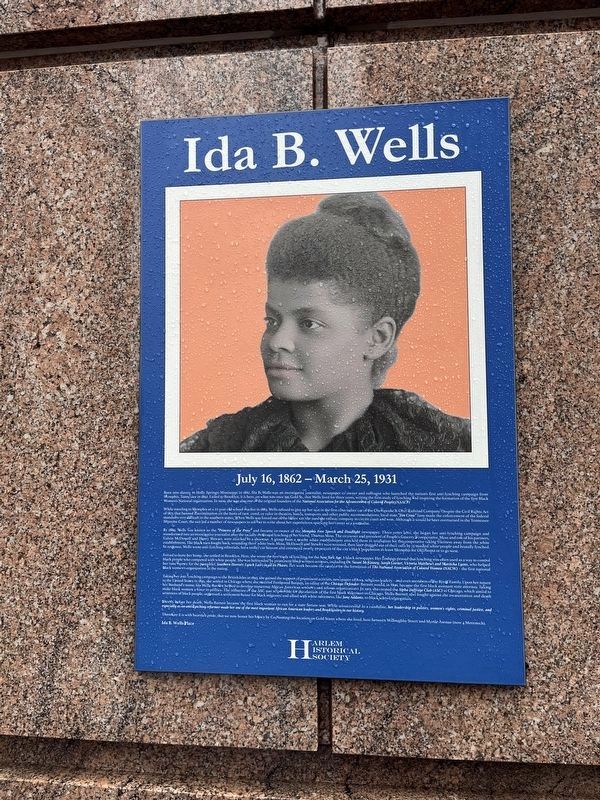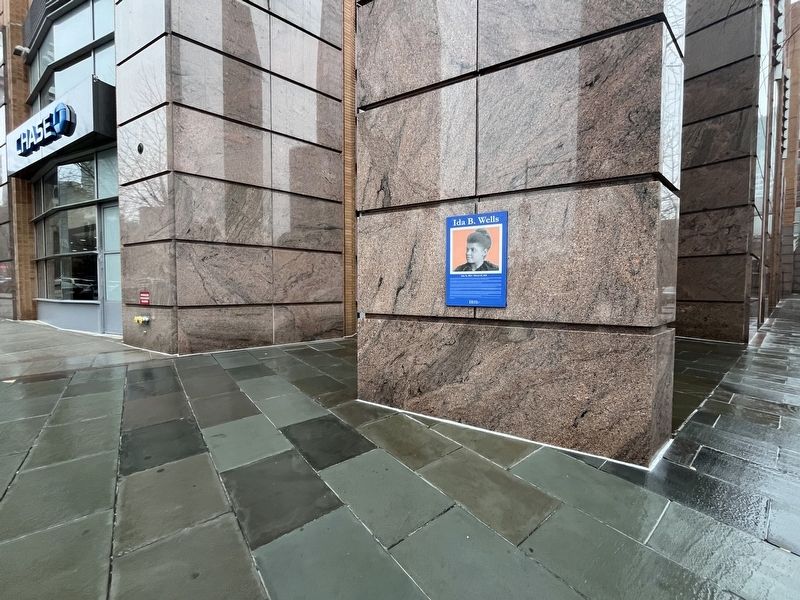Downtown Brooklyn in Kings County, New York — The American Northeast (Mid-Atlantic)
Ida B. Wells
July 16, 1862 - March 25, 1931
Born into slavery in Holly Springs, Mississippi in 1862, Ida B. Wells was an investigative journalist, newspaper co-owner and suffragist who launched the nation's first anti-lynching campaign from Memphis, Tennessee in 1892. Exiled to Brooklyn, it is here, on what was once 395 Gold St., that Wells lived for three years, writing the first study of lynching and inspiring the formation of the first Black Women's National organization. In 1909, she was also one of the original founders of the National Association for the Advancement of Colored People (NAACP)
While traveling to Memphis as a 22-year-old school teacher in 1883, Wells refused to give up her seat in the first class ladies' car of the Chesapeake & Ohio Railroad Company. Despite the Civil Rights Act of 1875 that banned discrimination on the basis of race, creed, or color in theaters, hotels, transports and other public accommodations, local state "Jim Crow" laws made the enforcement of the federal mandates very difficult in southern states. When Wells was forced out of the ladies' car, she sued the railroad company in circuit court and won. Although it would be later overturned in the Tennessee Supreme Court, the suit led a number of newspapers to ask her to write about her experiences, sparking her career as a journalist.
By 1889, Wells was known as the "Princess of the Press" and became co-owner of the Memphis Free Speech and Headlight newspaper. Three years later, she began her anti-lynching campaign and transformed into an investigative journalist after the racially-motivated lynching of her friend, Thomas Moss. The co-owner and president of People's Grocery, a cooperative, Moss and two of his partners, Calvin McDowell and Henry Stewart, were attacked in a shootout. A group from a nearby white establishment attacked them in retaliation for the cooperative taking business away from the white establishment. The black men fought back, wounding three white men. Moss, McDowell and Stewart were arrested, then later dragged out of their cells by 75 masked white people and brutally lynched. In response, Wells wrote anti-lynching editorials, led a trolley car boycott and convinced nearly 20 percent of the city's black population to leave Memphis for Oklahoma or to go west.
Forced to leave her home, she settled in Brooklyn. Here, she wrote the first study of lynching for the New York Age, a black newspaper. Her findings proved that lynching was often used as a way to control black people who competed with white people. She befriended by prominent black women activists, including Dr. Susan McKinney, Sarah Garnet, Victoria Matthews and Maritcha
Taking her anti-lynching campaign to the British Isles in 1893, she gained the support of prominent activists, newspaper editors, religious leaders — and even members of the Royal Family. Upon her return to the United States in 1895, she settled in Chicago where she married Ferdinand Barnett, an editor of the Chicago Defender. Barnett would, in 1896, become the first black assistant state attorney. Taking her husband's name, Ida Wells-Barnett helped to develop numerous African American women's and reform organizations. In 1913, she created the Alpha Suffrage Club (ASC) in Chicago, which aimed to make black women a force in politics. The influence of the ASC was responsible for the election of the first black alderman in Chicago. Wells-Barnett also fought against the incarceration and death sentences of black people, organized a settlement house for black migrants, and allied with white reformers, like Jane Addams, to block school segregation.
Shortly before her death, Wells-Barnett became the first black woman to run for a state Senate seat. While unsuccessful as a candidate, her leadership in politics, women's rights, criminal justice, and especially as an anti-lynching reformer made her one of the most important African American leaders and Brooklynites in our history.
Therefore it is with heartfelt pride, that we now honor her legacy by Co-Naming the location on Gold Street where she lived, here between Willoughby Street and Myrtle Avenue (now 4 Metrotech),
Ida B. Wells Place
Erected by Harlem Historical Society.
Topics. This historical marker is listed in these topic lists: African Americans • Civil Rights • Communications • Government & Politics • Law Enforcement • Women. A significant historical year for this entry is 1862.
Location. 40° 41.61′ N, 73° 59.026′ W. Marker is in Brooklyn, New York, in Kings County. It is in Downtown Brooklyn. Marker is at the intersection of Gold Street and Myrtle Avenue, on the right when traveling south on Gold Street. Touch for map. Marker is at or near this postal address: 126 Myrtle Ave, Brooklyn NY 11201, United States of America. Touch for directions.
Other nearby markers. At least 8 other markers are within walking distance of this marker. MetroTech / Downtown Brooklyn (within shouting distance of this marker); Wunsch Hall, Tandon School of Engineering (about 500 feet away, measured in a direct line); The Old Bridge Street Church (about 500 feet away); Did You Know? (about 600 feet away); a different marker also named MetroTech / Downtown Brooklyn (about 700 feet away); New York University Tandon School of Engineering (approx. 0.2 miles away); a different marker also named Did You Know? (approx. 0.2 miles away); a different marker also named MetroTech / Downtown Brooklyn (approx. 0.2 miles away). Touch for a list and map of all markers in Brooklyn.
Credits. This page was last revised on March 19, 2024. It was originally submitted on March 13, 2024, by Devry Becker Jones of Washington, District of Columbia. This page has been viewed 50 times since then. Photos: 1, 2. submitted on March 13, 2024, by Devry Becker Jones of Washington, District of Columbia.

